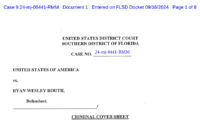A Timeline of Julian Assange’s Legal Saga
Julian Assange, the WikiLeaks founder who has long fought extradition from Britain to the United States, agreed on Monday to plead guilty to one count of violating the Espionage Act in exchange for a five-year prison sentence.
Under the agreement he will be freed, having already served that time while in British custody. The deal brought an abrupt end to an extraordinary legal saga that has raised novel issues of national security, press freedoms, politics and diplomacy.
Here is a timeline of significant events:
2006
WikiLeaks takes root.
Julian Assange, an Australian computer specialist, founds WikiLeaks with a mission of using the internet to help whistle-blowers bring hidden information to light. Operated by a transnational collective using servers in countries including Iceland and Sweden, it solicits classified, censored or otherwise restricted material for publication online.
2009
An Army intelligence analyst becomes a key contributor.
A U.S. Army intelligence analyst now known as Chelsea Manning downloads large batches of documents from a classified computer network and begins uploading them to WikiLeaks.
They include a video of a U.S. helicopter strike in Baghdad in which a Reuters photographer was killed, incident logs from the Afghanistan and Iraq wars, more than 250,000 diplomatic cables from American embassies around the world and hundreds of dossiers compiling intelligence allegations against Guantánamo detainees.
2010
WikiLeaks begins publishing the material.
The organization works with mainstream news outlets, including The New York Times. It initially appears that WikiLeaks may have numerous sources inside the U.S. government, and Mr. Assange is propelled to global notoriety. Eventually Ms. Manning is arrested and identified as the source of the wave of secret American documents.
The military initially holds her essentially in solitary confinement and under austere conditions intended to prevent suicide beyond when a doctor said that was necessary, prompting controversy over whether it is abusing her to send a message.
The Justice Department opens an investigation into WikiLeaks, and the Obama administration debates internally whether it can charge Mr. Assange with a crime without setting a precedent that would damage press freedom. Sweden issues an arrest warrant for Mr. Assange in connection to a sexual assault investigation. Credit cards and banks start refusing to process donations to WikiLeaks.
2012
Mr. Assange seeks asylum from Ecuador.
Mr. Assange, in Britain, loses his appeal of the Swedish warrant and violates bail, going into the Ecuadorean embassy in London. Ecuador grants him asylum based on his claim of political persecution and fear that he could be sent to the United States. He will spend the next seven years holed up in the embassy.
2013
Ms. Manning is convicted after a court-martial trial.
Ms. Manning, without the prospect of a plea deal, admits guilt but says Mr. Assange never directed any thefts. Ms. Manning is convicted of most charges, including violations of the Espionage Act, but she is acquitted of the most serious one — aiding the enemy, the military’s version of treason.
Ms. Manning is sentenced to 35 years in prison, the longest sentence in American history in a leak-related case. After the trial, Ms. Manning comes out as transgender and adopts the first name Chelsea; she is sent to a male military prison, where she twice attempts suicide.
Separately, Mr. Assange dispatches a WikiLeaks lawyer to help Edward Snowden, the former National Security Agency contractor who disclosed large batches of surveillance-related documents and ended up stranded in Moscow after the United States canceled his passport.
2016
WikiLeaks publishes hacked emails from Democrats.
At the height of the presidential campaign between Hillary Clinton and Donald J. Trump, WikiLeaks publishes Democratic emails that were hacked by a Russian intelligence agency. A batch is released on the eve of the Democratic National Convention and more troves are released as the campaign enters its final stretch.
2017
Ms. Manning’s sentence is commuted.
Shortly before leaving office, President Obama commutes most of the remainder of Ms. Manning’s sentence.
Early in the Trump administration, WikiLeaks publishes a series of files detailing C.I.A. surveillance and hacking tools. (Joshua Schulte, a former C.I.A. employee, will later be convicted in that leak.) In December, the Justice Department charges Mr. Assange in a sealed criminal complaint in connection with the Manning leaks — laying the groundwork to swiftly request his arrest and extradition should he leave the embassy in London.
2018
A court filing mistakenly discloses that Mr. Assange has been indicted.
The Justice Department obtains a grand jury indictment against Mr. Assange on a narrow charge of a hacking-related conspiracy for purportedly trying to help Ms. Manning. The indictment is sealed, but later that year a public Justice Department filing mistakenly reveals that Mr. Assange has been charged.
2019
Mr. Assange is arrested.
Swedish prosecutors drop their investigation into Mr. Assange. Ecuador revokes his asylum and invites the British police to enter the embassy and arrest him for violating his bail. (He is ultimately sentenced to 50 weeks in jail for that offense.)
The United States unseals the initial indictment, and later adds further charges. He ultimately faces two sets of accusations. One is a hacking-related conspiracy, for allegedly trying to help Ms. Manning and for encouraging hackers to steal American secrets and send them to WikiLeaks. The other — which carries significant implications for press freedoms — is over whether he violated the Espionage Act by soliciting and publishing American national-security secrets.
Mr. Assange, who is not charged for publishing the hacked Democratic emails in 2016 or the C.I.A. documents in 2017, will wage a long legal fight against extradition.
Proceedings in a Spanish court reveal that he was under covert video surveillance while inside the Ecuadorean embassy.
2021
The U.S. continues to seek Mr. Assange’s extradition.
A British judge blocks Mr. Assange’s extradition on the grounds that he might be at risk of suicide if held in an American prison.
The Justice Department appeals shortly before the Biden administration takes office. Rejecting entreaties from civil liberties organizations that it drop the charges against Mr. Assange, the new administration continues to press forward. It assures Britain that the U.S. government would not hold him under the most austere conditions reserved for high-security prisoners and that, if he were to be convicted, he could serve out his sentence in his native Australia. Based on those assurances, a British court later rules that he can be extradited, but years of further appeals ensue.
2022
A coalition of press advocates urge the U.S. to drop its charges against Mr. Assange.
A group of news organizations that worked with WikiLeaks in publishing the Manning disclosures, including The New York Times, asks the Biden administration to drop the charges against Mr. Assange that were based on obtaining and publishing classified diplomatic and military secrets. Their letter says charging such journalistic-style activities as a crime “sets a dangerous precedent” that threatens to undermine the First Amendment and the freedom of the press. (The decision to participate was made by the New York Times’s publisher, A.G. Sulzberger, and did not involve the newsroom.)
2022-2024
Mr. Assange’s appeal of his extradition grinds its way through the British courts.
The next hearing had been set for this July, when court documents indicated that he had struck a plea deal with the United States. Under the deal, he would plead guilty to one count of violating the Espionage Act and be sentenced to five years in prison, time already served for the more than five years that had elapsed since his arrest at the Ecuadorean embassy.


